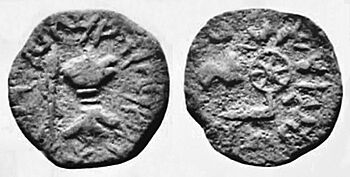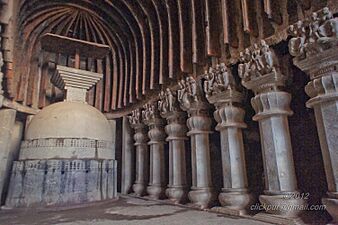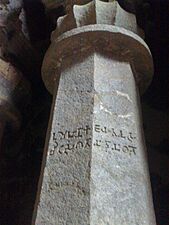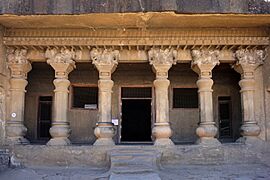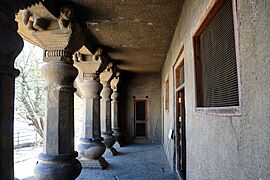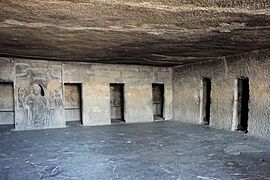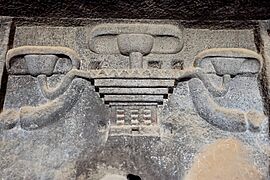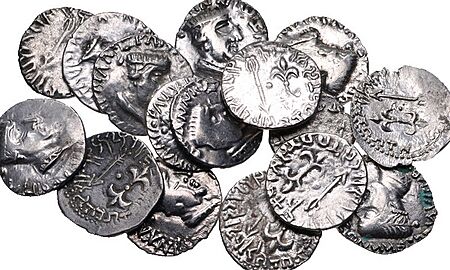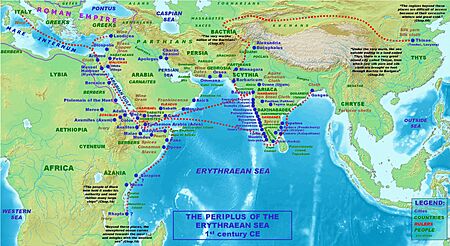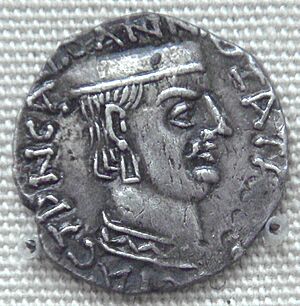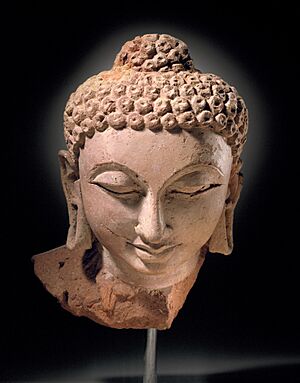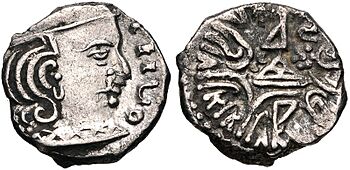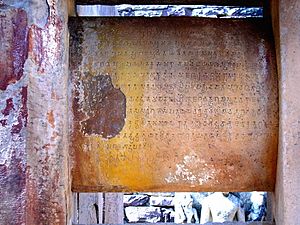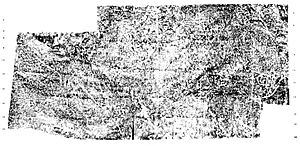Western Satraps facts for kids
Quick facts for kids
Western Satraps
|
|||||||||||||||||||||
|---|---|---|---|---|---|---|---|---|---|---|---|---|---|---|---|---|---|---|---|---|---|
| 35–415 CE | |||||||||||||||||||||
| Capital | Ujjain Barygaza Minnagara |
||||||||||||||||||||
| Common languages | Pali (Kharoshthi script) Sanskrit, Prakrit (Brahmi script) |
||||||||||||||||||||
| Religion | Hinduism Buddhism |
||||||||||||||||||||
| Government | Monarchy | ||||||||||||||||||||
| Satrap | |||||||||||||||||||||
|
• c. 35
|
Abhiraka | ||||||||||||||||||||
|
• 388–415
|
Rudrasimha III | ||||||||||||||||||||
| Historical era | Antiquity | ||||||||||||||||||||
|
• Established
|
35 | ||||||||||||||||||||
|
• Disestablished
|
415 CE | ||||||||||||||||||||
|
|||||||||||||||||||||
| Today part of | India Pakistan |
||||||||||||||||||||
The Western Satraps, also known as the Western Kshatrapas, were a group of rulers from the Saka people (who were Indo-Scythians). They controlled parts of western and central India from about 35 CE to 415 CE. Their kingdom stretched from Saurashtra in the south to Malwa in the east. This area includes parts of modern-day Sindh, Gujarat, Maharashtra, Rajasthan, and Madhya Pradesh.
These rulers lived at the same time as the Kushans in northern India. They also lived alongside the Satavahanas in Central India. Historians call them "Western Satraps" to tell them apart from the "Northern Satraps" who ruled in Punjab and Mathura.
The power of the Western Satraps began to weaken in the 2nd century CE. This happened after the Saka rulers were defeated by Emperor Gautamiputra Satakarni of the Satavahana dynasty. Although their kingdom recovered for a while, it was eventually defeated by Chandragupta II of the powerful Gupta Empire in the 4th century CE. The Western Satraps then quickly declined in the late 200s CE.
In total, there were 27 different Western Satrap rulers over about 350 years.
Contents
- Who Were the Western Satraps?
- History of the Western Satraps
- Western Satrap Coins
- Monuments and Buildings
- Contribution to Sanskrit Writing
- Were They Vassals of the Kushans?
- List of Rulers
- See also
Who Were the Western Satraps?
The Western Satraps were called "Satraps" on their coins. A "satrap" was like a governor or a viceroy who ruled a province for a larger king. The word comes from an old language called Median.
The main ruler was called the Mahakṣatrapa or "Great Satrap." The person who was next in line to rule was called a kṣatrapa. Indians also knew these rulers as Sakas.
The Western Satraps spoke the Saka language. This language is also known as Khotanese.
History of the Western Satraps
Early Rulers: The Kshaharata Dynasty (1st Century CE)
The Western Satraps likely began with the Kshaharata dynasty. The earliest known ruler from this group was Abhiraka. He was followed by Bhumaka, who was the father of Nahapana. Bhumaka used the title "Satrap" on his coins.
Nahapana became a very strong ruler. He took over parts of the Satavahana Empire in western and central India. Nahapana controlled areas like Malwa, southern Gujarat, and northern Konkan. This included important cities like Bharuch and Sopara.
Nahapana's son-in-law, Ushavadata, helped him rule. Ushavadata was a viceroy, meaning he governed a part of Nahapana's land. We know about him from inscriptions found in places like Nasik and Karle.
Nahapana also started using silver coins for the Kshatrapas. Around 120 CE, the Western Satraps joined forces with another group, the Uttamabhadras. They fought against the Malavas and defeated them.
Supporting Indian Religions
Inscriptions show that Nahapana and his family supported both Buddhism and Hinduism. For example, Ushavadata, Nahapana's son-in-law, made many donations. He gave cows and gold, and built places for religious practices.
One important inscription at the Great Chaitya in Karla Caves tells us about Ushavadata's generosity. He gave a village to support monks living in the caves at Valuraka. This gift was for all monks, no matter their group or background.
Building Buddhist Caves
The Western Satraps built and dedicated many Buddhist caves in central India. These caves are mostly found in Maharashtra and Gujarat. Nahapana ruled for at least 35 years in areas like Karla, Junnar, and Nasik. This gave him plenty of time to build these structures.
Many inscriptions in these caves mention Nahapana's family. There are six inscriptions in the Nasik Caves, one in the Karla Caves, and one in the Manmodi Caves at Junnar. Greeks, also known as "Yavanas," also left inscriptions in these caves, showing they donated money.
The Great Chaitya Hall at Karla Caves
The Karla Caves complex has the largest chaitya (prayer hall) cave in South Asia. It was built and dedicated around 120 CE by the Western Satrap ruler Nahapana.
- Great Chaitya hall at Karla
Cave No.10 of Nasik, the 'Nahapana Vihara'
Parts of the Nasik Caves, also called Pandavleni Caves, were also carved during Nahapana's time.
Inscriptions in Cave No. 10 at Nasik show that around 105-106 CE, the Kshatrapas defeated the Satavahanas. After this, Nahapana’s son-in-law, Ushavadata, donated 3,000 gold coins for this cave. He also provided food and clothing for the monks. Ushavadata's wife, Dakshmitra (Nahapana's daughter), also donated a cave for Buddhist monks. Cave 10, known as 'Nahapana Vihara', is very large with 16 rooms.
- Nasik Caves, cave No. 10
Two inscriptions in Cave 10 mention that Ushavadata, Nahapana's viceroy, built and gave the entire cave to the Buddhist community. He also built rest-houses, gardens, and water tanks in several cities.
International Trade and the Periplus
Nahapana is mentioned in an ancient book called the Periplus of the Erythraean Sea. This book describes trade routes and ports. It calls Nahapana "Nambanus" and says he ruled the area around Barigaza (modern-day Bharuch).
Under the Western Satraps, Barigaza was a major center for trade with the Roman Empire. The Periplus lists many goods that were traded. Things like wine, copper, tin, and coral were imported. Goods like spices, ivory, cotton cloth, and silk were exported.
The city of Ujjain, the capital of the Western Satraps, also sent many goods to Barigaza for trade. Some ships from Barigaza even sailed across the Indian Ocean to trade with other places.
An Indian statue called the Pompeii Lakshmi was found in the ancient Roman city of Pompei. It is believed that this statue traveled to Rome through the trade routes during Nahapana's rule. It might have been shipped from the port of Barigaza.
Defeat by Gautamiputra Satakarni
Nahapana and Ushavadata were eventually defeated by the powerful Satavahana king Gautamiputra Satakarni. Gautamiputra pushed the Sakas out of Malwa and Western Maharashtra. He forced Nahapana to move west to Gujarat.
We know about Gautamiputra's victory because he restruck many of Nahapana's coins. He also claimed victory in an inscription at the Pandavleni Caves in Nashik. The inscription says he "destroyed the Sakas" and "restored the glory of the Satavahana race."
Colonization of Java and Sumatra
It seems that some Indians moved to the islands of Java and Sumatra during the time of the Western Satraps. People might have left India because of the many conflicts happening there. Some old stories from Java say that the leader of the first colonists was Aji Saka. He was a prince from Gujarat and started the Shaka era, which is also the Java era.
New Rulers: The Kardamaka Dynasty (1st–4th Century)
A new ruling family, called the Kardamaka dynasty, was started by a ruler named Castana. Many historians believe his rule began in 78 CE. This date is important because it might be the start of the Saka era, a calendar system used in India. Castana was a satrap of Ujjain during this time.
A statue found in Mathura, alongside statues of Kushan kings, is often thought to be of Castana. This suggests that Castana might have been connected to the Kushans. The Rabatak inscription also says that the Kushan Empire controlled Ujjain during the time of their king Kanishka. This also hints at a connection between the Kushans and the Western Satraps.
Rudradaman I (130-150 CE)
Around 130 CE, Rudradaman I, Castana's grandson, became a "Great Satrap." He successfully defended his kingdom from the Satavahanas. The fighting was so intense that to make peace, Rudradaman's daughter married the Satavahana king Vashishtiputra Satakarni.
However, the war continued. Rudradaman I defeated the Satavahanas twice. He spared Vashishtiputra Satakarni's life only because they were now family. Rudradaman took back all the lands that Nahapana had once controlled.
Rudradaman was also known for supporting the arts. He wrote poetry in pure Sanskrit and made it the language of his court. He had a Greek writer named Yavanesvara in his court. Yavanesvara translated an important astrology book from Greek to Sanskrit.
Jivadaman (178-181 CE, 197-198 CE)
King Jivadaman became king around the 100th year of the Saka Era (178 CE). He was the first Western Satrap ruler to put the exact minting date on his coins. These dates, written in Brāhmī numerals, help historians understand the order of the rulers. His coins also mention his father, which helps trace the family tree. Jivadaman seems to have ruled twice.
Rudrasimha I (180-197 CE)
An inscription of Rudrasimha I was found in Setkhedi, dated to 185 CE. This shows that the Western Satraps had expanded their territory to the east by this time.
Great Satrap Rupiamma (2nd Century CE)
A memorial pillar with an inscription about "Mahakshatrapa Kumara Rupiamma" was found in Pauni. It dates to the 2nd century CE. This pillar suggests that the Western Satraps' conquests reached further south than previously thought.
Loss of Southern Lands
The Satavahana ruler Yajna Sri Satakarni (170-199 CE) defeated the Western Satraps in the late 2nd century CE. He took back their southern regions in western and central India. This led to a decline for the Western Satraps.
Yajna Sri Satakarni left inscriptions in places like Nasik Caves and Kanheri. These show that the Satavahana territory had grown again.
Rudrasena II (256–278 CE)
The Kshatrapa dynasty seemed to do very well under Rudrasena II (256–278 CE). He was the 19th ruler of the Kshatrapas.
Rudrasena II's family might have married into the Andhra Ikshvaku royal family. One of the Ikshvaku king's wives was the daughter of the "ruler of Ujjain," possibly Rudrasena II.
The region of Sanchi and Vidisha was taken back from the Satavahanas during Rudrasena II's rule. This is known from coins found in the area. This region stayed under Western Satrap rule until the 4th century CE.
The last Kshatrapa ruler from the Chastana family was Visvasena (293–304 CE). A coin of Visvasena was found during excavations at the Ajanta Caves.
Rudrasimha II Dynasty (c. 304–396 CE)
A new family took over, started by Rudrasimha II (304–348 CE). His coins say he was the son of a Lord (Svami) Jivadaman. His rule partly overlapped with his sons, Yasodaman II and Rudradaman II, who might have been sub-kings.
Contributions to Buddhism
Under Rudrasimha II, the Western Satraps continued to have a presence in central India. In 319 CE, a Saka ruler named Sridharavarman built a well on the hill of Sanchi. This shows the reach of Saka rule during Rudrasimha II's time.
Buddhist monuments were also built in Gujarat during the later part of Western Satrap rule. An example is the site of Devnimori, which has Buddhist monasteries and a stupa (a dome-shaped structure). Coins of Rudrasimha were found inside the Buddhist stupa at Devnimori. The Buddha images there show the influence of Greco-Buddhist art from Gandhara.
It is thought that the Western Satraps helped spread the art style of Gandhara to the western Deccan region of India.
Sasanian Expansion
The Sasanian Empire expanded into the northwest of India around 350 CE. This expansion likely affected the Western Satraps. It may have also ended the last parts of Kushan rule in the area.
Conquered by the Guptas (c. 335–415 CE)
The Western Satraps were eventually conquered by the powerful Gupta Empire.
Central India Conquered by Samudragupta
A Saka ruler named Sridharavarman had controlled the central Indian region around Vidisha and Sanchi. However, the Gupta Emperor Samudragupta (336–380 CE) likely defeated Sridharavarman's Sakas. Samudragupta's inscriptions suggest that Saka rulers had to "pay homage" to him. They even had to offer their daughters in marriage and ask for permission to rule their own areas.
Gujarat Campaign of Ramagupta
Rudrasimha III was likely the last Western Satrap ruler. An old Indian text says that the Gupta king Ramagupta attacked the Western Satraps in Gujarat.
The Gupta army got into trouble during the campaign. The Saka king, Rudrasimha III, demanded that Ramagupta give him his wife, Dhruvadevi, for peace. To avoid this shame, Ramagupta's brother, Chandragupta II, went disguised as the queen instead. Chandragupta then killed Rudrasimha. Later, he also killed his own brother, Ramagupta, and married Dhruvadevi.
Conquests of Chandragupta II
The Western Satraps were finally conquered by Emperor Chandragupta II (380–415 CE). Inscriptions from 412-413 CE at the Great Stupa in Sanchi celebrate Chandragupta II's victories.
Later, the Gupta ruler Skandagupta (455-467 CE) left a long inscription on a rock in Junagadh, Gujarat. This inscription confirmed that the Guptas now controlled the western regions.
After these conquests, the Gupta kings started making silver coins that looked like the Western Satrap coins. These coins had the ruler's face on one side. On the other side, they had a royal eagle (Garuda), which was the symbol of the Guptas.
These victories by Chandragupta II ended nearly four centuries of Saka rule in India. This period also saw the end of the last Kushan rulers and the arrival of the Huns from Central Asia.
Western Satrap Coins
The Western Satraps had very interesting coins. They were based on the coins of earlier Indo-Greek kings. They showed the king's face and had Greek writing on one side. The other side of the coins was unique. It usually showed a thunderbolt and an arrow. Later, it showed a chaitya (a three-arched hill) and a river symbol, with a crescent moon and the sun.
These coins are very helpful for historians. They record the king's name, his father's name, and the date the coin was made. This has helped clarify the early history of India.
Dating Coins
From the time of Jivadaman and Rudrasimha I, the exact date of minting was written on each coin. This date was in Brāhmī numerals and was based on the Saka era. This makes it very easy to know when each king ruled. This is rare for ancient Indian coins.
Also, the father of each king is always mentioned on the coins. This helps historians create a clear list of who ruled after whom.
Languages on Coins
The earliest coins of the Western Satraps used three scripts: Kharoshthi, Brahmi, and Greek. Kharoshthi was used in northern areas. However, after Chastana, only Brahmi and a kind of fake Greek script remained. These were used to write the Prakrit language. Sometimes, the legends were in Sanskrit.
For example, coins of Nahapana have Greek writing that means "In the reign of Kshaharata Nahapana." Coins of Castana say "In the reign of the Satrap Castana." After these two rulers, the Greek writing on the coins became unclear and didn't mean anything. It was kept only for its look.
Coin Influences
The coins of the Kshatrapas were very influential. Other dynasties, like the Satavahanas and the Guptas, copied them. The silver coins of Gupta kings Chandragupta II and Kumaragupta I used the Western Satrap design. They had the ruler's face on one side. On the other side, they replaced the hill symbol with a royal eagle (Garuda), the symbol of the Guptas.
The Western Satrap coin design was also copied by later dynasties. These included the Traikutakas and the Kingdom of Valabhi.
Monuments and Buildings
The Sudarshan Lake from the Satrap period is mentioned in old rock writings in Junagadh. However, no signs of it remain today. Six stone inscriptions, called Lashtis, from the 1st century were found near Andhau village in Kutch. They are the earliest dated monuments from the Satrap period. They were put up during the time of Rudradaman I.
Many stone inscriptions and hundreds of coins from the Satrap period have been found throughout Gujarat. The older caves in places like Sana, Junagadh, and Talaja are mostly simple. The Uparkot Caves of Junagadh and the Khambhalida Caves were built in the later years of the Satraps.
Ancient Buddhist stupas (mound-like structures) found near Junagadh also belong to the Satrap period.
Contribution to Sanskrit Writing
Interestingly, Sanskrit inscriptions appeared much later than Prakrit inscriptions in India. This is because Prakrit was favored since the time of the famous Edicts of Ashoka (around 250 BCE).
Most early Sanskrit inscriptions date to the time of the Indo-Scythian rulers. These include the Northern Satraps and, a bit later, the Western Satraps. It is thought that these rulers promoted Sanskrit to show their connection to Indian culture. They wanted to be seen as legitimate Indian rulers.
In western India, the first known Sanskrit inscription was made by Ushavadata, Nahapana's son-in-law, at the Nasik Caves. This inscription is from the early 2nd century CE.
The Junagadh rock inscription of Western Satrap ruler Rudradaman I (around 150 CE) is very important. It is the first long inscription written mostly in standard Sanskrit that we still have today. This inscription was a turning point for Sanskrit writing. It is believed to be the model for the many Sanskrit inscriptions of the later Gupta Empire.
During Rudradaman's rule, a Greek writer named Yavanesvara translated a Greek astrology book into Sanskrit. This translation became very important for later astrology works in India.
The Western Satraps also likely helped spread the use of Sanskrit inscriptions to southern India. They had close ties with southern Indian rulers.
Were They Vassals of the Kushans?
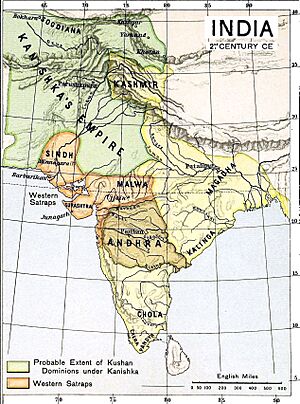
It is not fully clear if the Western Satraps were independent rulers or if they were under the control of the Kushan Empire (30–375 CE). The fact that they kept using the title "Satrap" suggests they might have recognized a higher ruler, possibly the Kushan emperor.
A statue of Chastana was found in Mathura alongside statues of Kushan kings. This suggests a close relationship, perhaps even that Chastana was a vassal (a ruler who owes loyalty to a more powerful king) of the Kushans. Also, the Kushan king Kanishka claimed that his power reached Ujjain, the capital of the Western Satraps. This also points to a connection.
Historians generally believe that the Western Satraps were vassals of the Kushans, at least in the early period. However, this question is still being debated by experts.
List of Rulers
- Family Tree
See also



